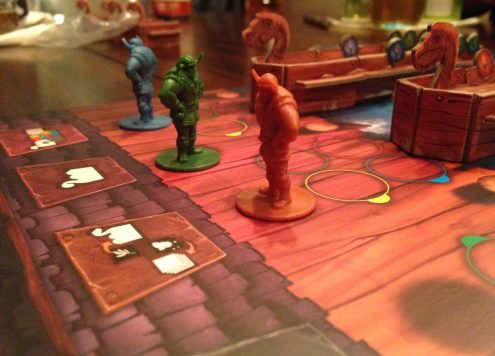PHOTOSYNTHESIS (Blue Orange Games)
David Attenborough once said that, “the natural world is the greatest source of excitement; the greatest source of visual beauty; the greatest source of intellectual interest.” Photosynthesis takes from this source as you play through the growth of a forest, by planting, growing and ending the life cycles of your trees.
Starting the game with just two small trees on the outskirts of a meadow, game rounds in Photosynthesis start with the Photosynthesis Phase, where players collect Light Points from their trees based on size. However as the sun circles the board, the trees cast shadows on each other – blocking trees of the same size or smaller from collecting Light Points. Bigger trees cast bigger shadows and a once welcoming meadow quickly fills into a dense, old growth forest.
The second part of the round is the Life Cycle Phase, where players spend Light Points to take actions. Actions include buying seeds and trees to become available from their player boards, casting off available seeds from their trees already on the board, growing available trees, and completing the life cycle of a tree to receive a Scoring Token for that location.
After all players have completed the Life Cycle Phase, the sun rotates and the first player token is passed off for a new round to begin. When the sun completes three rotations around the board (four for an advanced game) the game is over and Scoring Tokens are added to determine the winner.

There’s a lot to like about Photosynthesis. With clearly defined and limited actions each turn, explaining the game can be done in a matter of minutes. However how the game plays out from these limited actions is anything but simple. Each turn is an evaluation of the sun’s changing position to determine how to maximize your light collection and block the light collection of your opponents, all while knowing that the only way to score points is to end the life cycle of your tree. If you want to play the game strategically, there’s a lot to think on as you plan for two, three sun positions out.
The other immediately apparent thing to like about Photosynthesis is that it’s a beautiful game. The illustrations are wonderfully done and the three-dimensional pieces perfectly convey the game’s concept while sticking with good old affordable cardboard. With board gaming’s current popularity and the explosion of Collector’s Editions and seemingly endless Kickstarter stretch goals, not every box needs to be super-sized and filled with finely detailed (and expensive) miniatures. With Photosynthesis there’s no sacrifice of the aesthetic for value, just a well-thought out execution on both. (Blue Orange Games) by David C. Obenour









Social Media